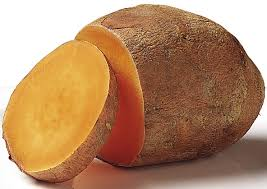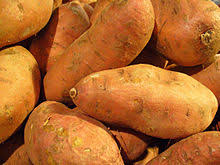Sweet Potato
 Common Name: Sweet potato, yam
Common Name: Sweet potato, yam
Scientific Name: Ipomoea batatas
Climate: Temperate and hot. It prefers tropical and subtropical climates. It does not withstand frost.
Plant Description: It is a herbaceous, perennial and climbing plant, known for its edible tuberous root. The stems are green or purple and grow up to eight meters tall. The ovulated green leaves can be whole or toothed. Its bell-shaped flowers open during the day and close at night.
Cultivation: Sweet potato reproduction can be done with cuttings or from its own tubers. For reproduction by cutting, young stems are used, which are planted directly. Reproduction using tubers consists of planting them directly in the ground. In subtropical climates, tubers are planted in the spring just before the start of summer. If the stems are pruned, it produces more roots and tubers. Sweet potatoes mature between three and six months.
It grows best in deep, well-drained, aerated, and organic-rich soils. Although it needs moist soils, it can rot with excess water. It is sown in full sun and needs up to ten hours of sun daily for its full development.1
 Uses: It is a tasty food that contains iron and contributes to a healthy immune system, helping to prevent cancer and protect against the effects of aging. It contains starch, vitamins, fibers and minerals, especially potassium. The tuber can be used as the potato or as a sweet dessert. The leaves can be eaten as a salad or used as farm animal fodder.
Uses: It is a tasty food that contains iron and contributes to a healthy immune system, helping to prevent cancer and protect against the effects of aging. It contains starch, vitamins, fibers and minerals, especially potassium. The tuber can be used as the potato or as a sweet dessert. The leaves can be eaten as a salad or used as farm animal fodder.
Pests and Diseases: It is affected by excess nitrogen and is vulnerable to various pests. The best method of pest control is crop rotation, establishing a minimum of one year between two plantations in the same area; ensuring that there are no cracks in the ground where insects that feed on the roots can enter; destruction of crop residues.2
References:
En español: Camote
